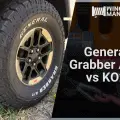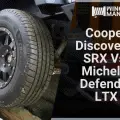Winter is almost officially over. Spring is right around the corner. What does this mean for your driving? Well, it means no more snow. However, it also means the snow will melt, compound that with spring rain, and you have yourself new road problems.
Mud now takes the place of snow – at least in the offroad world. What can you do to make your tires work in the mud? What can you do to increase traction in slippery muddy terrain? Do tire chains work in mud as well as they work in the snow?
What Tire Chains Do
Tire chains, otherwise commonly known as snow chains, are devices specifically fitted to the tires of vehicles to provide maximum traction in slippery terrain. As the name implies, they are commonly used for snow. Although they work flawlessly on ice as well.
However, it’s not advisable to always use tire chains every time you see a snowflake drop from the sky. You should only use tire chains when the roads are covered in ice or snow. Without a layer of ice or snow on the road, tire chains will dig through the road itself instead of the snow. Ultimately, this will damage the road. But when there is snow or ice, that is what the tire chains will dig through – not the road.
There are tire chain laws that differ from state to state. So be sure to be well-acquainted with the laws in your area before driving with tire chains. Your local government doesn’t want you damaging the roads loyal taxpayers funded.
Using Tire Chains in the Spring
Can you use tire chains in the spring? That depends on where you use it. When the snow and ice from winter melt in spring, they make the ground muddy. But not the roads – at least not the concrete roads. It is NOT advisable to use tire chains on concrete roads during the spring. You will end up damaging the road.
However, if you’re going offroad during the early days of spring, you might consider bringing a set of tire chains with you.
Tire Chains Work in Mud
Offroad trails tend to get muddy during the early days of spring. Melted ice and snow plus spring rains make for slippery terrain. But guess what? Tire chains work in the mud.
Tire chains allow you to gain more traction – it doesn’t choose the terrain, really. When we drive in snow or mud, the snow or mud gets into the treads of the tires. This is why the tires lose traction (it is different with ice – ice is just very slippery).
Tire chains allow the tires to get a grip on the terrain. The speed of spinning wheels clears the snow and mud away. Then the chain adds traction while the tire treads are filled with either mud or snow.
This is why the better name to describe these devices is “tire chains” – because they are not only suitable for snow. They are merely called snow chains because they are most commonly used in snowy situations.
While mud tires have about 50% more traction compared to street tires when both are in deep mud – tire chains increase the traction by 4 times that of street tires. That’s an increase in traction by about 300%!
When is it Practical to Use Tire Chains?
If you have a winch, when is it practical to use tire chains? After all, tire chains have limitations, legally wise.
Well, if you are driving through an offroad trail and part of the trail is covered in mud, it’s better to use tire chains, especially if the mud-covered area extends for more than a few yards. It’s not practical to drag your vehicle through a mile of mud using a winch, is it?
Also, if there are no anchor points available and you don’t have a winch ground anchor, tire chains are the better option.
You don’t want to use tire chains in the sand, though. Tire chains will dig through sand like a hot knife through butter. Your vehicle will get stuck – and if you managed to dig very deep, even the strongest Warn winch might not get you out of there.
How to Use Tire Chains Properly?
At a Glance
Legal Concerns
Tire chains bite the surface of the ground it is used on. Its small surface area plus the weight of the vehicle puts a lot of pressure on the surface it is on. With that said, it is illegal to use it in some places like national parks or roads when roads are not icy.
Be sure to be aware of the laws in the area before fitting your tires with chains.
Fit Chains Early On
If you know that you will not break any laws by using tire chains, it is wiser to fit them on your tires beforehand. You don’t want to get stuck in mud first before attaching the tire chains. You will struggle with jacking up your vehicle to attach the chains when it is already in deep mud.
Just make sure that you won’t traverse any roads or pavement when the chains are already fitted on the tires. You will damage the road, pavement, and maybe even your tires.
Drive Slowly
Check the manual of the tire chains. It should have a speed limit when in use. Tire chains drastically increase the heat generation of the speedily spinning wheels. You might end up damaging your wheels due to the heat generated by the high speed of spinning.
Drive in low gears while maintaining minimal throttle. Keep your driving under 30 miles per hour. Let the tire chains do the work.
Take Them Off When No Extra Traction is Needed
Only use the chains when you need extra traction. And when you need them, it’s best to have chains on every tire, no matter whether you’re driving a four-wheel-drive vehicle or not. It’s hard to compensate when only a pair of wheels have them.
Conclusion
Yes, you can use tire chains in the mud. But it requires careful observance of driving safety rules and common sense.
We have a lot of helpful offroading guides on the site. Be sure to check them out!



